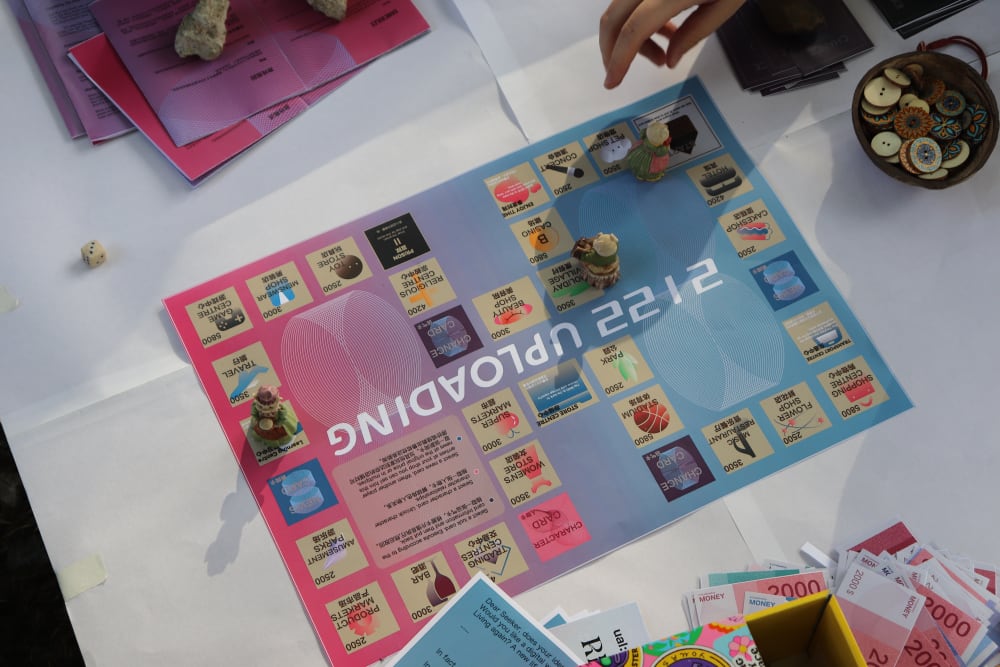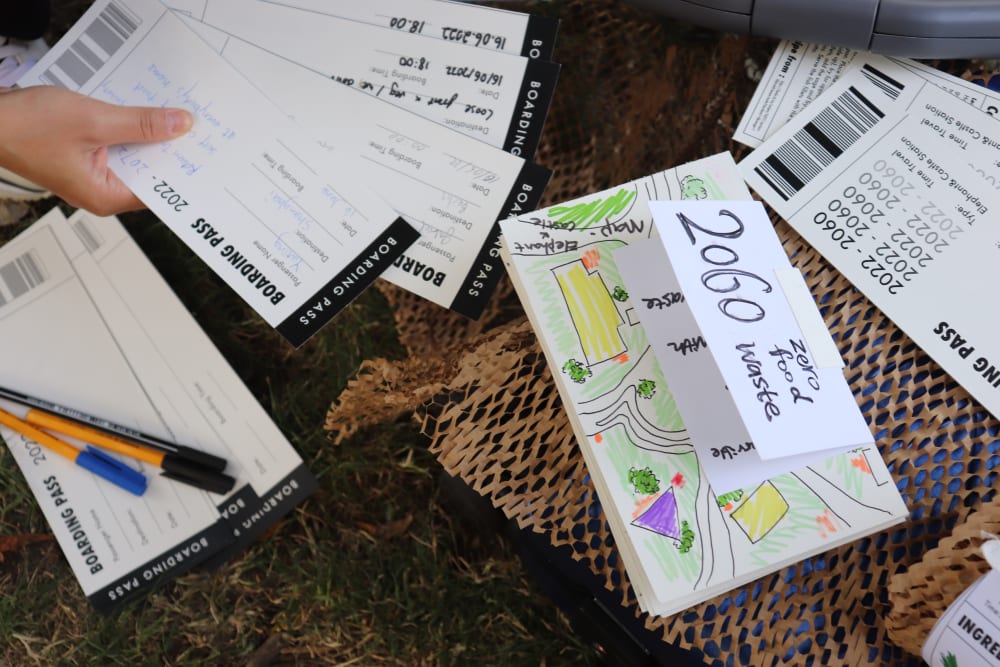
Futures Rendezvous Guerrilla Exhibition Learnings by Rijul Narwal

- Written by
- Published date 13 July 2022

Future Rendezvous Guerrilla Exhibition by London College of Communication's (LCC) MA Design for Social Innovation and Sustainable Futures students by Rijul Narwal, LCC, and UAL Post-Grad Community Ambassador
The ’Futures Rendezvous’ was a guerrilla exhibition set up by the MA Design for Social Innovation and Sustainable Futures students at LCC. This 4-hour long exhibit took place on the 16th of June, at the St Mary’s Churchyard near LCC. As a part of our speculative design unit, we brought back artefacts from our speculative futures to engage with people in the present. While a wide range of topics and themes floated in the air that evening, ranging from mutual aid, freedom of speech, gender stereotypes, soil care, future of food; my peers and I walked away with a big chunk of practical learnings from this setup. Communication is hard enough. Communicating your ideas to your peers also takes effort. And communicating why you are demanding changes as a designer to the public/wider audience is an even bigger challenge. Studying in a design setup, we often forget that we might have created a bubble inside our university where we might be talking to like-minded people about things, we are passionate about. However, how do we communicate this as strongly to others beyond this bubble? Here are some of our learnings from this journey, so that you can prepare better in the future:
1. Let’s check the weather
Though an open space brings natural light and fresh air, it also means that we do not have control over the weather. While setting up for the exhibition, many of my classmates including myself were struggling to set up our projects because of the wind. This included trying to manage falling structures, flying banners and looking for blind spots from the wind.
2. Be willing to approach people
Being in a non-traditional set-up, can mean a lot of things. One of them is also, that while we set up, though there were people looking, they were not sure what was happening in the park. Many of them looked curious about what we were doing and we were scared to approach them. However, once someone made the first step, the crowd kept pouring in.

3. Visiting the space in advance
We visited the park as a class in the morning of the exhibition. This helped us identify which spots we wanted to use. However, this also meant that when we visited the place, some of us were posed with the question of what would we place our artefacts on? Will it take the support of a tree? Do we want it on the grass or the concrete? Do we need it at an eye-level? Can we wear it around?
4. Should we leave the stats in the report?
Very often, facts and figures might not be as powerful to our audience, as they were to us. This can especially be the case when the audience has nothing to compare it to. It is essential to bring out your data and information in context.

5. Add value to their time
An impromptu exhibition scenario also meant that the people who were in the park were not all aware of the exhibition taking place. Some of them were with their children, their friends and even their pets. It was important to deliver an experience that would fit in their relaxed evening rather than a research-loaded, all-encompassing project. Whether it was role-playing from the future or getting people to participate, the humour and absurdity caught their attention!

6. Prepare to interact with different age groups
Our exhibition took place in a park which meant that there were many kids as well! This is something a lot of us overlooked when preparing for the exhibition. We were so engrossed in our topics and research that we forgot to think of who we would be interacting with.

7. Develop different narratives, along with a key takeaway
With a diverse audience, comes diverse thinking. It is not always easy to gage what your audience thinks which can make engagement scary. However, think of it as an iterative process. What is the one key takeaway you want people to walk away with? What’s that one thought? Using this, we can put together different ways our artefact can be explained, or our story can be told. Use these different narratives to interact with different people. Within a few engagements, it can help you assess which narrative got the most engagement, so that you can use that forward.

8. Give them a hook
To engage and converse with people, it is important to involve your audience and make them think. If you want to understand how your artefact/object makes them feel, ask them a question but don’t give them the answer you are looking for right out. While this might not be applicable everywhere, some of us found that people responded with greater interest when they were challenged to look at the artefact through different lenses.

9. Prototype, but go the extent
When we think of living in the future, we tend to think of a lot techy and sci-fi gadgets and tools. We might think big with multi-sensory inputs and outputs. Our future artefact might be extremely detailed in our head, but it proves to be a difficult task to translate that into the present. Many students showed their creativity by harnessing current technology to make-shift a futuristic experience. They queued lights and speakers in their artefacts to give the effect of their future artefacts.

10. Stay hydrated
4 hours was a long period of time full of short and long conversations. Though the temperatures were not extremely warm, all the talking and walking around did require us to drink plenty of water and take a snack break when we got the chance.

This, of course, is not an exhaustive list; nor is it a universal one. However, I do hope it gives you a starting point for how you can prepare for your future exhibition!
What is a Guerrilla Exhibition?
A Guerrilla exhibit is an impromptu exhibition which is set up in contrast to the traditional idea of clean white walls in a massive museum space.
Related links
- Follow Rijul on Instagram
- Follow Post-Grad Community on Instagram to hear more about our events
- ArtsSU
UAL Post-Grad Community
Established in 2013, Post-Grad Community is an inclusive platform for all UAL postgraduate students to share work, find opportunities and connect with other creatives within the UAL and beyond. Find out more
Post-Grad Stories
A thriving online magazine of our postgraduate student voices sharing thought-provoking experiences, practices, thoughts and articles about what matters to them.
Download the PDF Guide to writing articles for Post-Grad Stories
Want to write an article? Get in touch with the Post-Grad Community team PGCommunity@arts.ac.uk